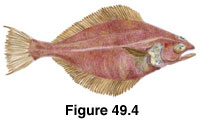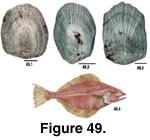 Description
Description
Atheresthes stomias
(Arrowtooth Flounder)
(Other common names: Long-Jawed Flounder, Needle-Toothed Halibut, French Sole)
Figure 49.4
 Description
Description Length: 84 cm (females larger than males).
Mouth: very large, terminal; near symmetrical with wide gape; maxillary extends beyond posterior margin of lower orbit; snout is pointed; teeth well developed on both sides of jaws and are arrow-shaped.
Body: compressed; caudal penduncle long; caudal fin slightly lunate; dorsal fin originals over middle of upper eye; left eye on upper margin of head; dorsal branch absent on lateral line.
Color: brown to olive on eyed side; white with fine black spots on blind; darker margins on scales.
Depth: up to 900 m (generally shallower).
Habitat: soft substrate.
Season: spawning occurs December through February; larvae in the water column in summer.
Diet: larvae eat small crustaceans (e.g., copepods, shrimp); adults also crustaceans and other forage fish species (e.g., herring, anchovy, sand lance, pollock)
Predators: not determined.
Distribution: southern California to the Bering Sea.
 Scale Description
Scale DescriptionNote: no ctenoid scales are illustrated.
Relative Scale Size: moderate.
Position of Scales on Body: on lateral line canal; approximately 135 scales; unevenly imbricated pattern; deciduous; ctenoid on eyed side, cycloid on blind side (Hart, 1973).
Overall Shape: circular to square; regenerated scales tend to be more circular. The lateral fields are slightly longer than the anterior is wide. The posterior field can be straight to slightly curved.
Focus and Circuli: the focus is distinct and falls within the anterior portion of the posterior field. It is approximately one-fifth to one-sixth of the total scale length from the edge of the posterior field. The circuli are compact and continuous in all fields.
Radii: numbers are variable and not diagnostic. Presently only in the anterior field (radii not present in all fields; Batts, 1964). Intermarkings present and are not brick-like (Batts, 1964); they are not perpendicular to the circuli. The outer edge of the anterior field is convex to slightly fluted (is not scalloped).